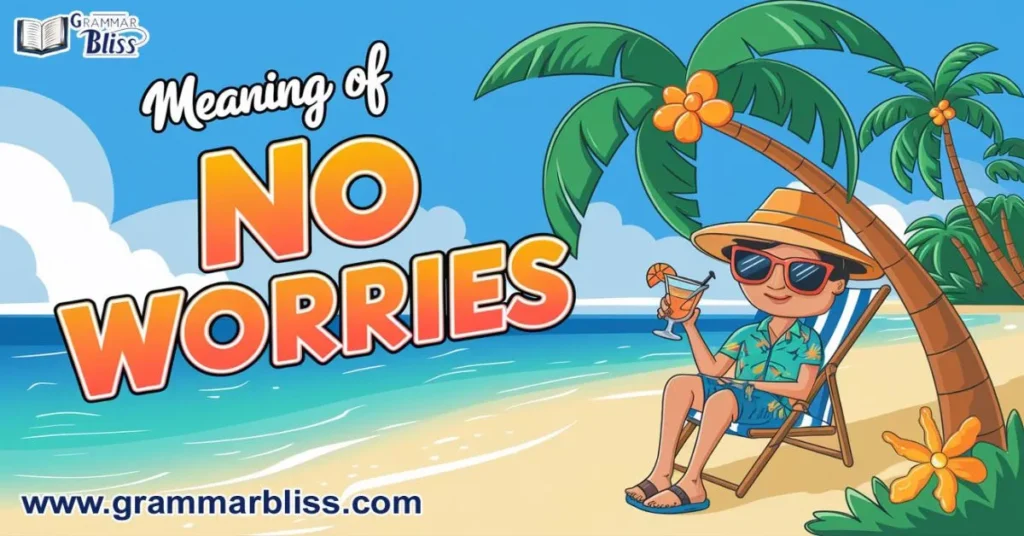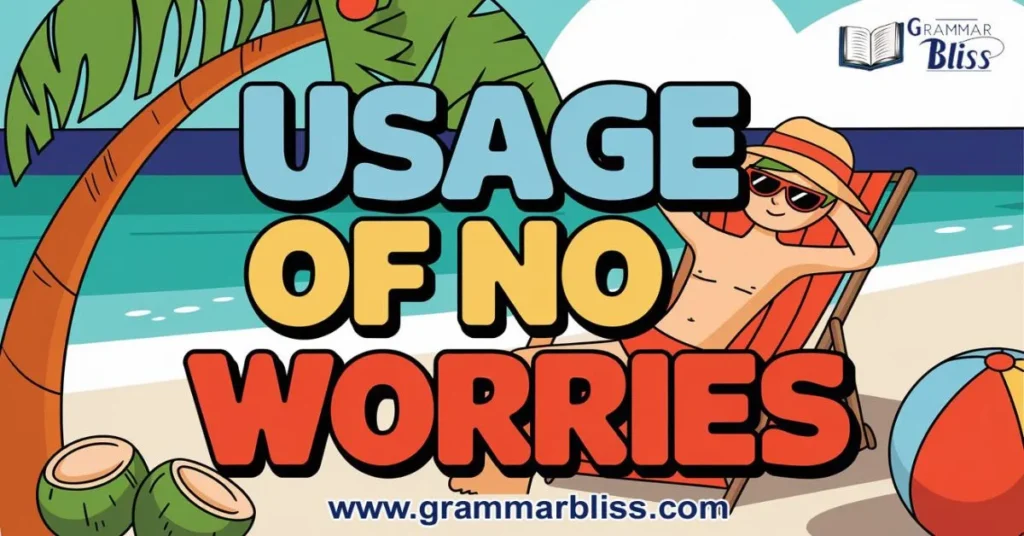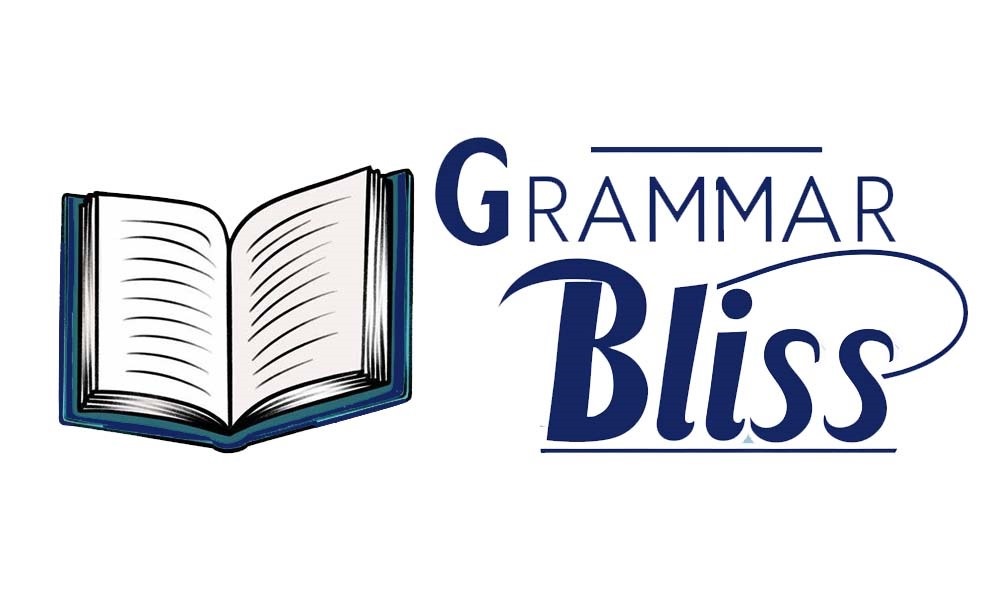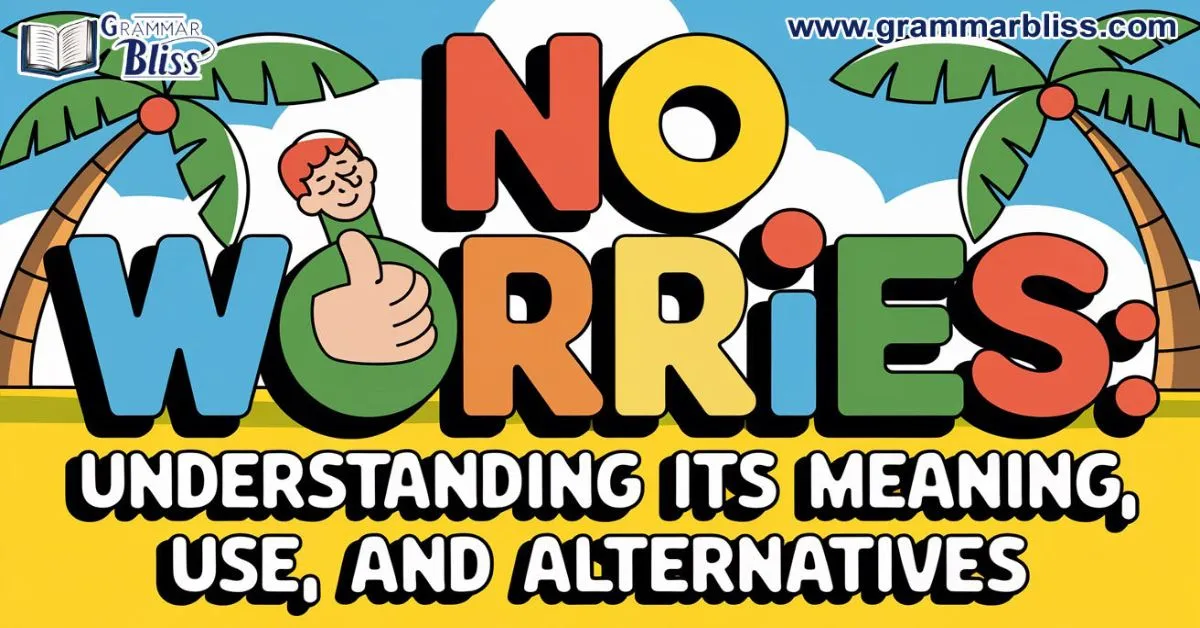In everyday communication, we often find ourselves using the phrase “No Worries” to convey reassurance or indicate that everything is fine. However, while this casual phrase works well in many informal situations, it might not always be the best choice. Depending on the context, tone, and setting, it can come across as too informal or even dismissive.
For more effective communication, especially in professional environments, choosing the right words is crucial. Here, we’ll explore the meaning of “No Worries,” discuss when it’s appropriate to use, and provide several synonyms and alternatives to help you communicate with empathy and professionalism.
Quick Summary
The phrase “No Worries” has become a common part of casual communication. It’s often used to assure someone that everything is fine or to tell them not to worry. While it works well in informal situations, its use in professional settings requires more thought. It’s important to understand the phrase’s meaning, its impact on relationships, and how it can be interpreted based on tone and context. Let’s dive deeper into the specifics of “No Worries” and explore its alternatives.
Read: acception-or-exception-master-the-terms
Meaning of “No Worries”

At its core, “No Worries” is a phrase used to express reassurance or to indicate that something is not a problem. It’s often used in informal conversations to let someone know that they don’t need to be concerned about something. For instance, if a friend thanks you for helping them move, you might say “No Worries,” meaning it wasn’t a hassle at all. It’s also used to soften the impact of an apology, such as when someone says, “Sorry for being late,” and you respond with, “No worries.”
The phrase carries a friendly, nonchalant tone and conveys a sense of warmth. It’s a casual way to express that there’s no need for concern or guilt. However, while “No Worries” is widely understood in casual settings, it’s essential to recognize that its tone can feel too informal or even dismissive in more serious or professional contexts.
Usage of “No Worries”

Knowing when to use “No Worries” is crucial. The phrase shines in informal interactions, such as with friends, family, or even colleagues in a relaxed workplace culture. When someone thanks you for a favor or an action, replying with “No Worries” helps maintain a light and friendly atmosphere. It also works well in situations where you want to reassure someone that they don’t need to feel guilt or stress over something small.
However, tone and context matter. If you use “No Worries” in a formal setting or when speaking to a client, the phrase can sometimes come across as too casual or dismissive. Imagine a scenario where a customer is apologizing for a mistake; saying “No Worries” might alleviate their concern in a friendly way, but it could also undermine the professionalism needed in the conversation.
In business communication, the phrase’s lack of seriousness can create issues. For example, in an email to a colleague or client about an important matter, using “No Worries” might feel overly casual and not convey the professional tone needed to maintain proper workplace etiquette.
“No Worries”: Is It Professional to Say?
While “No Worries” is widely accepted in informal settings, it doesn’t always fit well in formal conversations, especially in the workplace. If you work in a client-facing role or have more formal interactions, you may want to avoid using it unless you are confident it fits the tone and context. In these settings, phrases like “I’m happy to assist,” or “It’s my pleasure,” might offer the same reassurance but with a more polished and professional feel.
In industries like customer service, tech, or creative fields, where communication style is often more laid-back, “No Worries” can be completely appropriate. It aligns with a more colloquial and friendly workplace culture. However, in industries with a more formal workplace culture, like law or finance, a more traditional phrase such as “You’re welcome” or “It was no trouble” is usually a better choice.
Advantages and Disadvantages of Saying “No Worries”
Advantages of Saying “No Worries”
- Casual and Friendly: It creates a relaxed and friendly atmosphere in informal conversations.
- Reassuring: It helps to alleviate someone’s concern or guilt, letting them know everything is fine.
- Diffuses Tension: Perfect for lightening the mood and easing any awkwardness or tension.
- Simple and Easy to Use: A quick, easy-to-understand response that doesn’t require much thought.
- Shows Willingness to Help: It expresses that you’re happy to assist without making a big deal out of it.
Disadvantages of Saying “No Worries”
- Too Casual for Formal Settings: In professional or formal situations, it may seem too informal and dismissive.
- Misinterpreted: It can be seen as a lack of empathy if the person is truly apologizing or is concerned about something important.
- Overused: Repeated use can make the phrase feel less original and reduce its effectiveness or warmth.
- Lack of Politeness: It might come across as nonchalant in situations where more thoughtful or empathetic responses are required.
- Missed Opportunity for Deeper Connection: In more serious conversations, alternative responses might better reflect understanding or compassion.
Synonyms of “No Worries”
Here are some alternatives to “No Worries”:
- It’s My Pleasure
Meaning: A polite way of saying you’re happy to help.
Example: “Thanks for your help with the project!” “It’s my pleasure!” - Glad to Help
Meaning: Expresses willingness to assist.
Example: “Thanks for lending me your notes!” “Glad to help!” - No Problem
Meaning: Indicates that there’s no trouble or difficulty.
Example: “Sorry for being late.” “No problem, we’re just getting started.” - Don’t Mention It
Meaning: A way to say that no thanks are necessary.
Example: “I appreciate you covering my shift today.” “Don’t mention it!” - It Was Nothing
Meaning: A modest way to downplay a favor or effort.
Example: “Thank you for helping me move!” “It was nothing!” - Happy to Assist
Meaning: Formal and polite way to say you’re willing to help.
Example: “I appreciate the quick response to my request!” “Happy to assist.” - Anytime
Meaning: Suggests you are always available to help.
Example: “Thanks for helping with that report!” “Anytime!” - Not a Problem
Meaning: Expresses that the task was not difficult or inconvenient.
Example: “I’m sorry for the mix-up.” “Not a problem, it’s all sorted now.” - You’re Welcome
Meaning: A polite response to someone’s gratitude.
Example: “Thanks for your help!” “You’re welcome!” - It’s No Trouble
Meaning: A polite way of saying that something wasn’t difficult.
Example: “Thanks for helping me with the documents.” “It’s no trouble.” - I’ve Got You Covered
Meaning: Means you will take care of the situation.
Example: “I’m worried about meeting the deadline.” “Don’t worry, I’ve got you covered.” - Happy to Lend a Hand
Meaning: Willing to help or assist someone.
Example: “Thanks for your help with the presentation!” “Happy to lend a hand.” - It’s All Good
Meaning: A casual way of saying that everything is fine.
Example: “Sorry for the misunderstanding.” “It’s all good!”
Learn: 10 Kinds of Adjectives: with Example
- You Bet
Meaning: An enthusiastic way of saying “You’re welcome” or agreeing.
Example: “Thanks for the favor!” “You bet!” - Anytime, Just Ask
Meaning: A way to let someone know they can reach out to you whenever.
Example: “Thanks for helping me move my couch!” “Anytime, just ask.” - Not At All
Meaning: A polite way to say that something is not a bother.
Example: “Thanks for the help with the cleaning.” “Not at all!” - It’s My Pleasure to Help
Meaning: A more formal way of saying you’re happy to assist.
Example: “I appreciate the quick reply!” “It’s my pleasure to help.” - I’m Always Here for You
Meaning: Offering support or help anytime.
Example: “Thanks for always supporting me!” “I’m always here for you.” - That’s What I’m Here For
Meaning: Emphasizes that helping is your purpose.
Example: “Thanks for answering all my questions.” “That’s what I’m here for!” - It Was My Pleasure
Meaning: A polite and formal response to show you were happy to help.
Example: “I really appreciate your advice.” “It was my pleasure.” - No Inconvenience at All
Meaning: A formal way of saying it didn’t cause any trouble.
Example: “I appreciate your time today.” “No inconvenience at all!” - I’m Happy to Help
Meaning: Expresses joy or willingness to assist.
Example: “Thank you for your time and effort.” “I’m happy to help.” - It’s No Problem
Meaning: Casual expression to say it wasn’t an issue.
Example: “Thanks for understanding.” “It’s no problem!” - I’m Glad I Could Help
Meaning: Expresses happiness that you were able to assist.
Example: “Thanks for fixing the issue.” “I’m glad I could help.”
Explore: To Fast or Too Fast? Understanding the Key Difference
Grammar Rules and Examples
While “No Worries” is an easy phrase to use, it’s important to understand how it fits into sentences. It should typically be used in informal exchanges to respond to thanks, apologies, or reassurance requests. For example:
- “Thank you for covering for me!”
“No worries, happy to help!” - “Sorry for the delay!”
“No worries, take your time.”
You should avoid overcomplicating the sentence. Keep it simple and make sure the tone is appropriate for the conversation. In formal settings, such as emails to clients or superiors, more polished alternatives like “It’s no trouble” or “I’m happy to assist” work better.
FAQ’s
Is “No Worries” professional to say in emails?
It’s typically too casual for formal emails; use more polite alternatives in professional communication.
When is it appropriate to use “No Worries”?
It’s best used in informal settings or casual conversations where reassurance is needed.
Are there formal alternatives to “No Worries”?
Yes, phrases like “You’re welcome” or “It was my pleasure” are more formal and appropriate in professional contexts.
Is saying “No Worries” overused?
Yes, it can feel repetitive and lose its impact when used too frequently.
Conclusion
“No Worries” is a widely used and casual phrase that can help diffuse tension and offer reassurance, it’s important to consider the context in which it’s used. In more formal or professional settings, opting for a more polished response may be more appropriate. Understanding the tone and the level of empathy required in different situations allows you to choose the right words that maintain professionalism and respect. Ultimately, your word choice plays a key role in strengthening relationships and improving communication.

